
Would you like to start a conversation with other industry leaders to brainstorm a challenge or to just know more on a particular topic?
Engage in online discussions with your Peers
Start NowAll organizations irrespective of their size and stage of evolution need to drive business excellence and  focus on building organizational capabilities by developing management systems, processes and models to improve performance, create value, and achieve superior business results. It is about achieving excellence in everything that an organization does including leadership, strategy, customer focus, information management, people and processes. It includes continuous improvement, management by metrics and reengineering. This is all the more relevant for organizations that focus on Business Process Services (BPS), whether through off shoring, near shoring, or on shoring, under captive shared services or outsourcing operations.
focus on building organizational capabilities by developing management systems, processes and models to improve performance, create value, and achieve superior business results. It is about achieving excellence in everything that an organization does including leadership, strategy, customer focus, information management, people and processes. It includes continuous improvement, management by metrics and reengineering. This is all the more relevant for organizations that focus on Business Process Services (BPS), whether through off shoring, near shoring, or on shoring, under captive shared services or outsourcing operations.
Business Excellence & Capability Models
Over the last 2 decades, with India becoming the hub for off shoring, several global and domestic corporations have moved towards BPS, redesigning and transforming business processes in multiple domains (covering manufacturing and services sectors) and multiple functions (IT, Operations, F&A, Customer Service, HR, SCM etc.,).
The use of these Excellence models will depend on the stage of the
company in its growth journey, its need and tolerance for strict rigor,
and on what the expected outcome is.
These organizations have been constantly seeking to use and apply structured Business Excellence and Capability Models to help them follow a rigor while sustaining or expanding their operations to achieve excellence. Many models are systematic behavioural assessment models and have been in use for long. Some of them are more sophisticated and have an in-built complex set of parameters to be followed for strict adherence.
The chart below depicts an indicative list of Business Excellence and Capability Models:
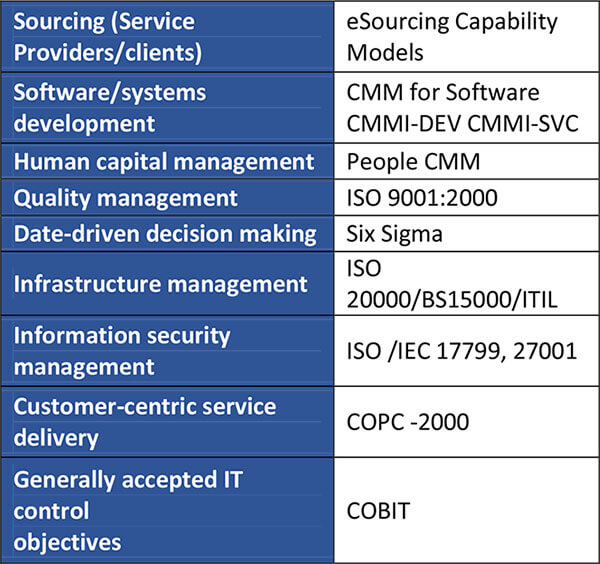
Largely these models could be bucketed in two: Quality Models (six sigma, lean, etc.) that essentially improve processes and Capability Models (COPC, eSCM, etc.) that improve overall service delivery and enhance organizational capabilities. Within this, COPC is intended for restricted or limited application to customer service and contact centres, and there is no model as comprehensive like eSCM which can be adopted for all Business Process Services across functions, whether IT Services, Contact Centre Operations or IT Enabled Services.
eSCM – The Business Excellence Model for Business Process Services
In the year 2001, IT Services Qualification Center (ITSqc) at Carnegie Mellon University, supported by an industry consortium comprising leading global players in the IT-enabled services space released the first version of the eSourcing Capability Model (eSCM) as a “best practices” capability model for the rapidly growing IT and ITeS off shoring/ outsourcing industry.
The eSCM models contain best practices, and are used as a
reference to drive improvement in IT-enabled insourcing/
outsourcing relationships.
There has been a metamorphosis in this space globally and within India, which now comprises growing number of Global In-house Centres (GICs) and BPO Outsourcing Majors with multiple centres across the globe as well as Domestic Shared Services and small/mid-size BPOs with many centres locally. The GICs have now turned into Global Business Service Centres, and have become the umbrella hub for managing captive as well as third party operations for the same parent company.
The framework, eSCM-SP (Service Partner) - helps all service partner organizations to improve the relationship between Service Partners and the Clients. In the case of GICs or SSCs, the parent companies become the clients since they receive the services from these centres. Similarly, eSCM has also developed a complementary capability model for the Client/ Parent Company organisations, called eSCM–CL (Client) to address full life cycle from sourcing strategy to service management across the two sides of relationships.
eSCM SP - Business focus much beyond just Quality focus:
From a Service Partner perspective (like GICs, SSCs and BPOs), it is most appropriate to adopt eSCM SP best practices model.
The broad Business Process Services architecture involved in any form of offshoring/shared services/ outsourcing is shown here to understand the comprehensive coverage of eSCM (SP).
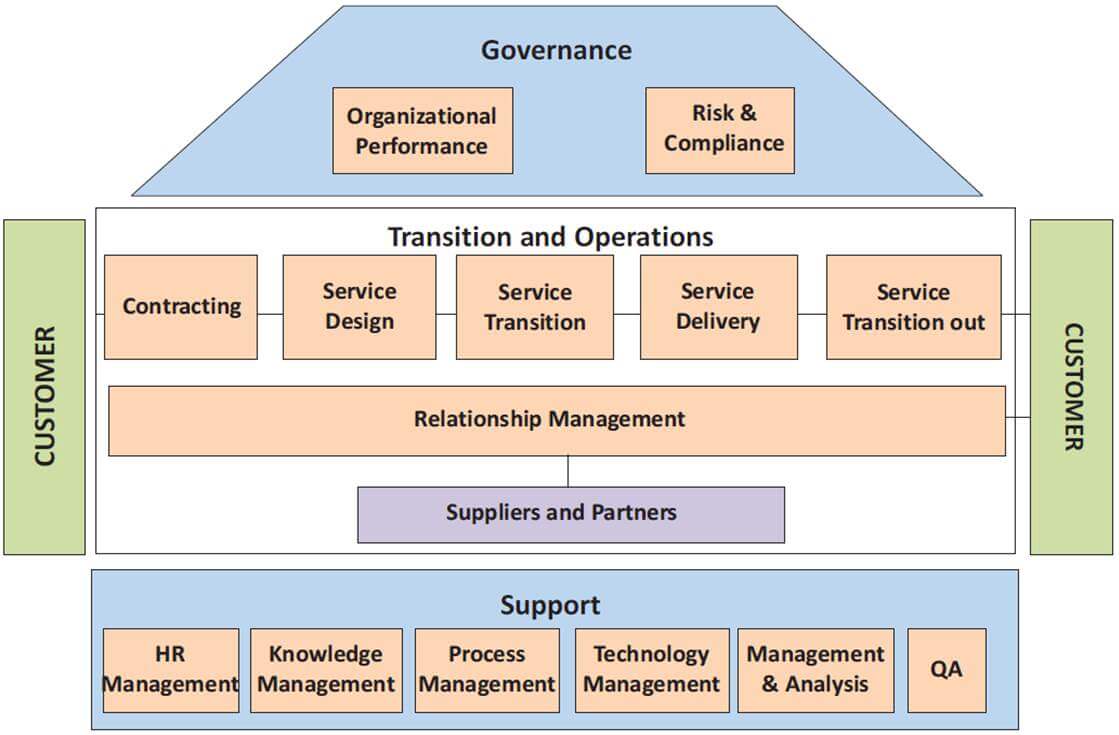
Most common mistake is to adopt this eSCM SP model as a quality process framework. This model is an amazing combination with simultaneous or parallel focus on operations and strategy, service delivery and value delivery, short term (issue resolution and control enhancement) and long term (innovation, intellectual property and relationship management).
E2E focus on Sourcing Life Cycle – Strategy to Service Management
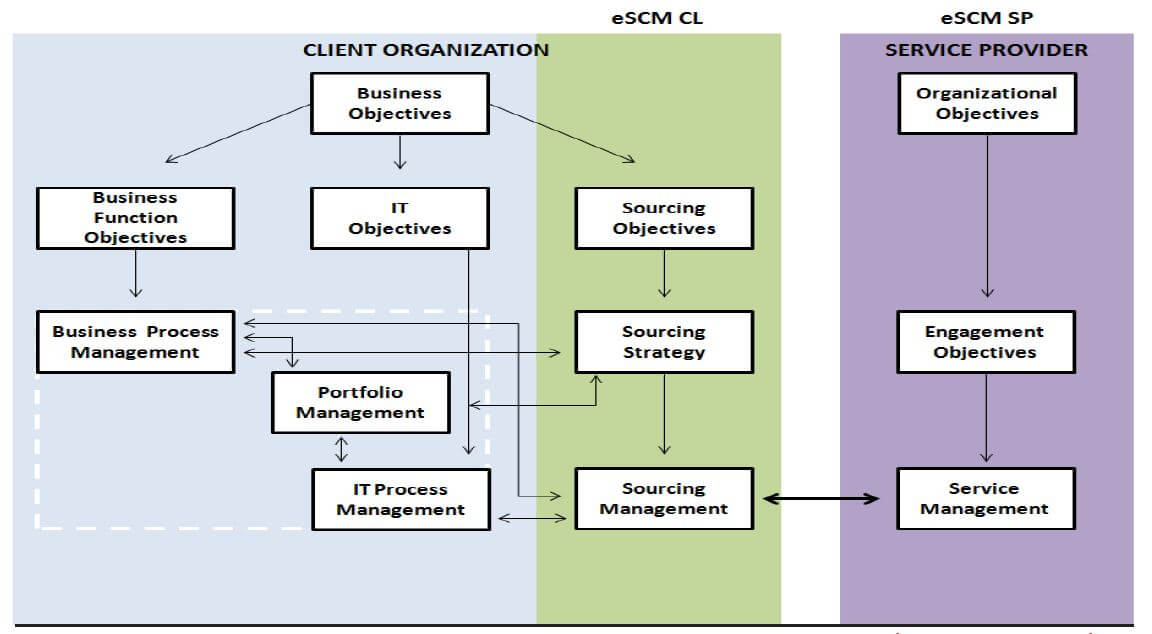
Hence, this model is truly a business excellence model much beyond quality, best applied when led by a Business or Practice Leader who is accountable for this linkage and relevance to derive the best value from eSCM-SP. Even when the Quality team is leading such initiative, it needs to be viewed as a business requirement and most essential to get that level of commitment and involvement from the Business team. If this is not ensured, it becomes another model for writing up processes and focus shifts towards compliance rather than achieving excellence.
Overall, SSCs and BPOs are recommended to use eSCM as a framework for
benchmarking and truly achieving and sustaining excellence.
The best starting point is to apply eSCM (SP) for current state assessment and gap analysis and then creating a road map to enhance capabilities. The certification can be a sequential action and can be planned as soon as the adoption of best practices becomes part of the organization's culture. Certification would be a confirmation of the adoption and the most important aspect lies in achieving excellence in organizational capabilities to sustain high quality service and value delivery.
Value Differentiators
eSCM has several value differentiators for Shared Services and BPOs and they are:
- eSCM helps to manage and reduce risks, improve organizational capabilities & progressively achieve higher levels of quality of services - from Level 2 to Level 5.
- Most models focus only on design and delivery capabilities, but eSCM extends from initiation till completion of contract. It has been designed to complement and supplement existing capability models including COPC, so that service providers can capitalize on their previous improvement efforts.
- For SSCs, eSCM Assessment lays a solid foundation for all types of operations - data, voice or non-voice,
- and benchmark against external service providers to move from Level 2 (Brilliant at Basics), to Level 3 (Functional Excellence), to Level 4 (Proactively Add Value) and finally, to Level 5 to sustain excellence. Each eSCM-SP Capability Level indicates current capability of an organization.
- eSCM goes well beyond documentation to confirm how well the stated policies and procedures are actually followed/ implemented in the business through review of artifacts, demonstrations/ and unobtrusive observations.
- eSCM triggers strategic thinking and improvement projects that can lead to BPT in SSC/ BPO companies.
- For Shared Service Centers/ Outsourcing Partners the opportunities are to:
- Demonstrate Capabilities of Business Services
- Compare Capabilities of Multiple Centers/ Client Engagements
- Improve Overall Effectiveness of Business Processes
- Showcase Capabilities for Business Expansion
- Use as a Tool for Continuous Improvement
eSCM (SP) – Holistic Framework
eSCM (SP) is holistic framework with 10 Capability areas, 84 Practices with 700+ activitieors sub practices spread across Level 1 to 5, as explained in figure below:
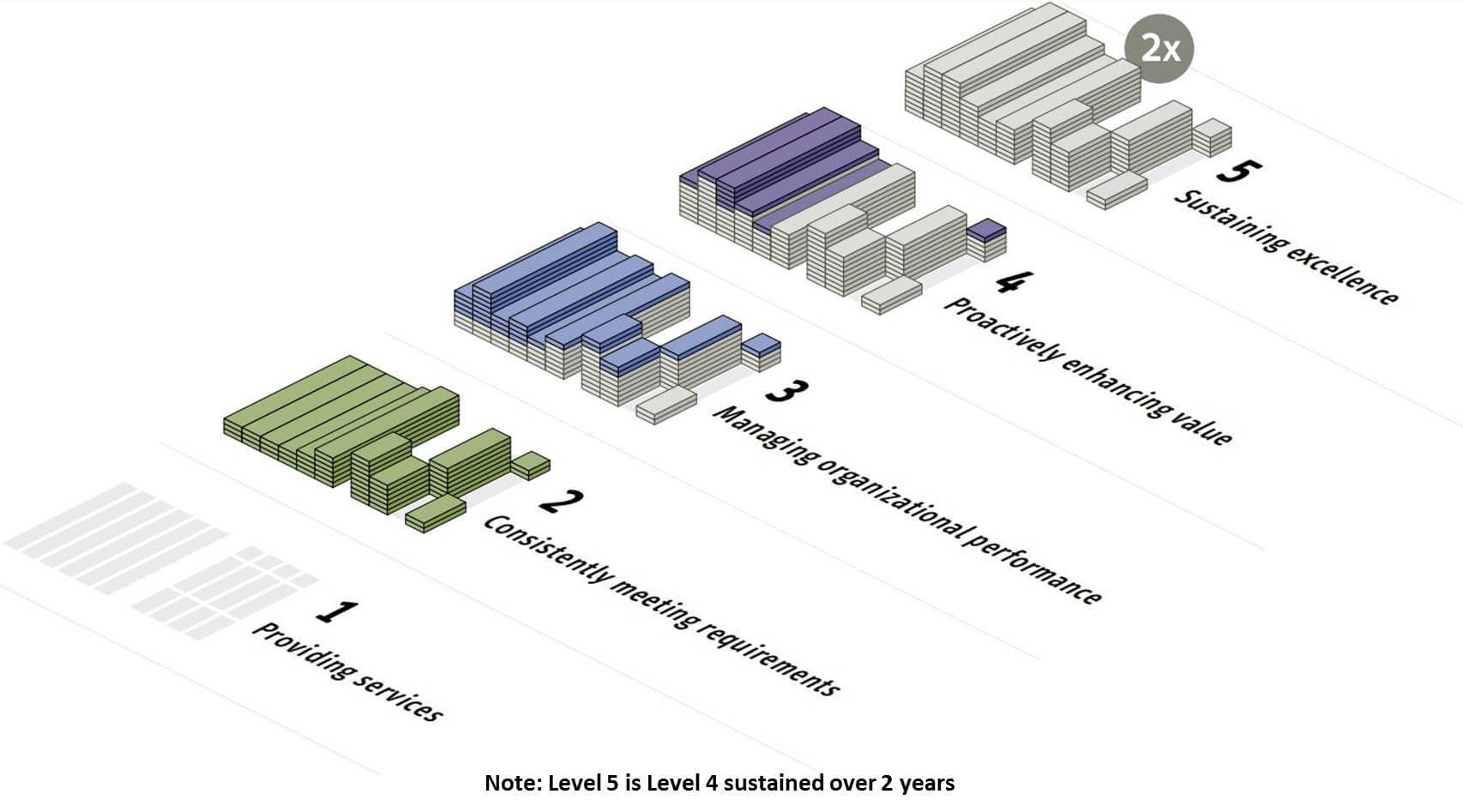
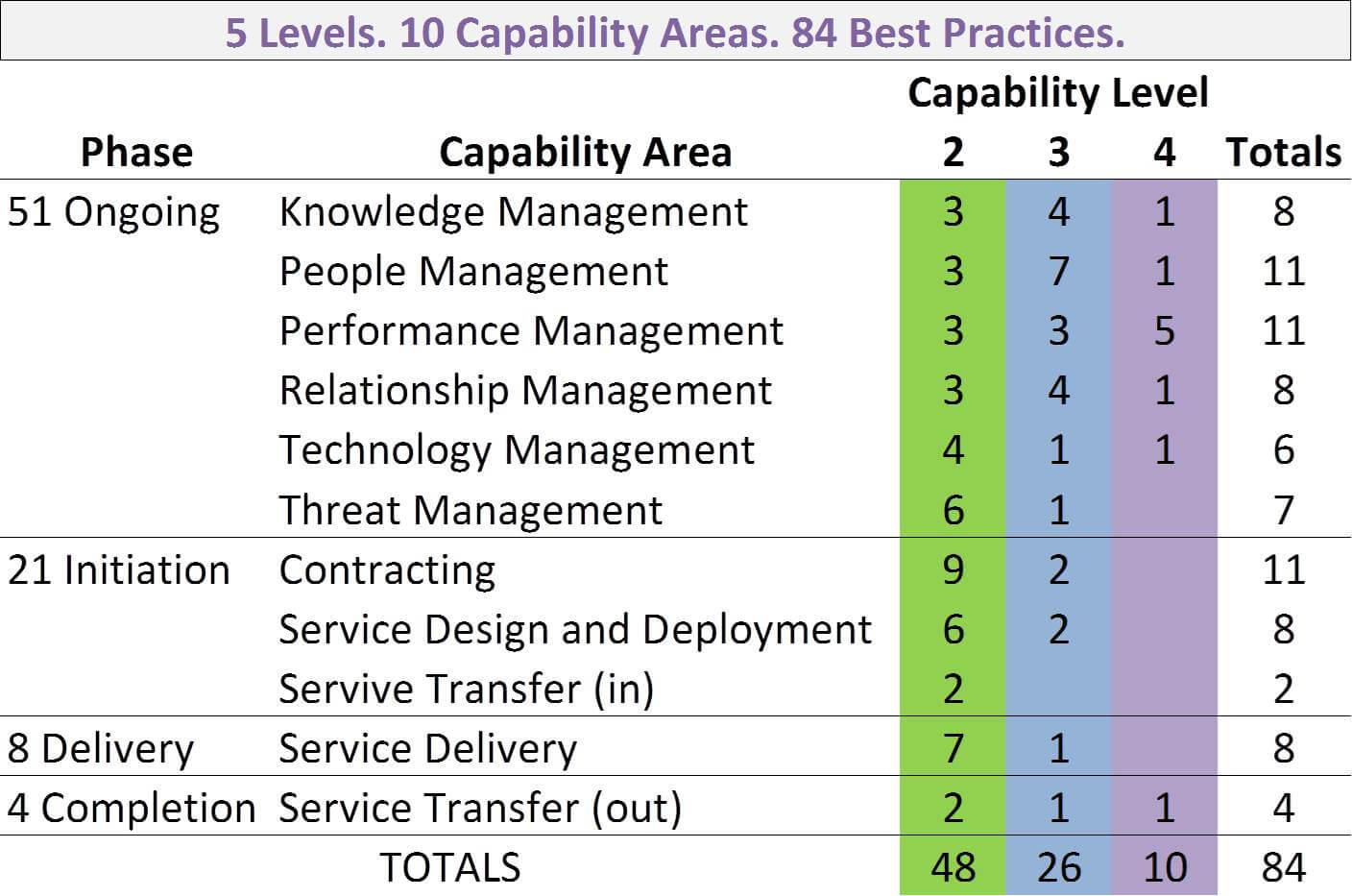
eSCM Model at a glance
The Model covers both the core capabilities for service transition and service delivery as well as certain organizational capabilities to sustain higher levels of value delivery. Some of the key highlights are as under:
Contracting: The processes involved in the contracting phase are addressed in this capability area and it covers requirement gathering, due diligence, contract negotiation and pricing. Even in the case of GICs and SSCs where there is one parent company, this capability has provided deeper impact since quite often there are several businesses or countries within the same parent company, but also it captures the 'reverse commitments' required from these internal customers, much beyond a SLA.
The eSCM models are relevant now more than ever, considering the
changing order in global outsourcing.
Service design: This capability area addresses handoff from the contracting team (deal team) to the transition team, developing service specification, creating service design and review of service design. This is well implemented in a GIC or SSC environment where there is a Program Management team working as bridge, for BPOs this is very crucial since quite often what is promised by the contracting team is not carried forward during transition to operations.
Service Transfer: This capability area addresses transfer of resource and personnel (if any) from the client or Sending Center and it is very crucial in terms of people movement and enable knowledge transfer requirements. For any reason, if any process needs to be 'reverse transitioned', the service provider should transition the services ensuring continuity of services. This confirms that the model goes beyond mere service delivery to people movements and process re-transitions.
Service Delivery: This capability provides a comprehensive focus on steady state delivery covering service management, service reporting, corrective and preventive actions, control requirements, service modifications, training of clients or end users and financial management.
Relationship management: This capability area is quite unique to eSCM-SP, focusing on client/internal customer relationship management and extends to suppliers and partners relationship management that support the operations and services from the centre. Under this area, eSCM-SP requires service providers to look for opportunities for value creation for clients, much beyond standard relationship management aspects, to move the value chain.
Governance: Governance related practices are addressed in two capability areas of eSCM-SP. “Performance management” capability area addresses organizational performance management that includes setting objectives, defining plans, reviewing progress and benchmarking. The “Threat Management” capability area addresses enterprise risk management, information security management and compliance to regulatory and statutory requirements.
Service support: Human resource management is a key element of any service. “People management” capability area of eSCM - SP provides elaborate best practices.
People and Performance: These 2 capability areas weave in all other capability areas. People practices focus on defining roles, connecting personnel competencies with the workforce competencies, performance feedback & career development, rewards, encouraging innovation to share few. Similarly Performance capability area focus on connect between engagement objective to organizational objectives, reviewing & improving both engagement level and organizational level performance, performing capability baselines & bench marking, and deploying innovations.
Knowledge management: Under this capability area, focus is on encouraging and infusing the culture of knowledge sharing through a policy, defining process assets, organizing these knowledge assets in a system, ensuring version & change control, reusability and tracking resource consumption.
Technology management: This capability area addresses the guidance for integration with client's technology environment, license management, controlling changes to technology infrastructure, optimize performance of technology and proactively introduce new technology.
In a nutshell, eSCM-SP does address all business processes required for delivering sourcing services. Since the practices are rated in varying capability levels ( 2, 3 and 4), service partner organizations have an option to start adopting the basic level practices first (Level 2) and then mature their capability by adopting the advanced level practices.
One size does not fit all
Collection of best practices provided in the eSCM-SP is a valuable body of knowledge. The success of eSCM implementation lies in how well it is interpreted and used in the context of the organization's unique environment. This is another major requirement of implementing any best practices model. As mentioned earlier, the eSCM-SP provides 84 best practices. From the Model perspective, all practices are of the same weightage or importance. However, it is not expected that all 84 practices have to be implemented by all organizations simultaneously or all practices should be implemented in a similar manner across organizations regardless of their nature of their business structure. For example, contracting practices are very critical for a third party service provider while for a captive unit providing shared services, this capability area can be taken up later, if there is some level of formal agreement with the parent company, with negotiated pricing or charge-out mechanism and contract terms.
Also, we find many of the service partners missing out on some basic level practices (Level 2 practice like intellectual property or culture fit training) while adopting certain higher level practices. eSCM SP clearly advocates that it is essential all Level 2 practices are fulfilled to achieve the desired capability of value delivery before focusing on higher level practices. All process models including eSCM-SP allows “process tailoring” that means you need to modify the processes to suit your business need and not vice versa i.e. modify the process just to satisfy the 'words' of the model rather than spirit of the model, which is the business need.
Capability Determination Stages
In order to make eSCM as a way of life to sustain excellence, Service Partner organizations can start with a quick diagnostic and go up to evaluation for certification.
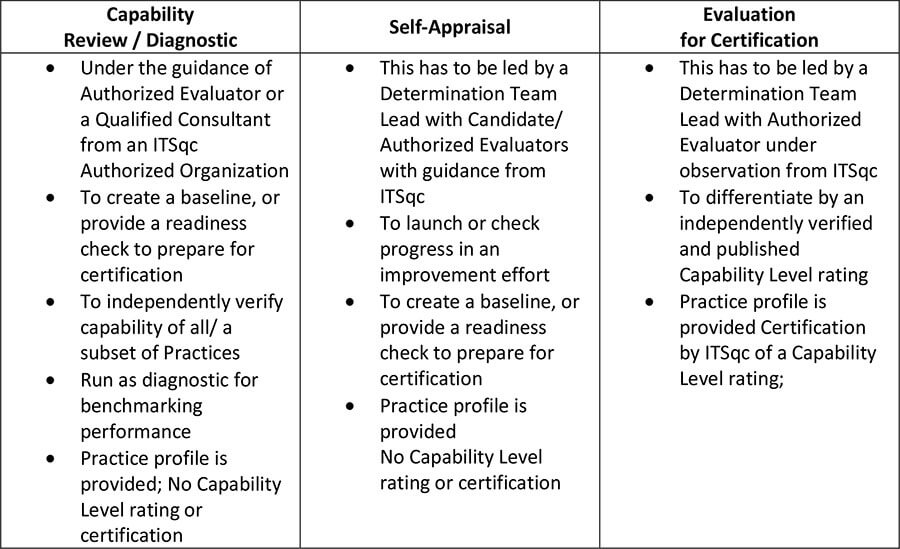
Stages of Assessment & Evaluation
Scope for the above can be either Full i.e. covering all 84 Practices or Mini i.e. any subset of practices as identified by the organization. It is organizations priorities and focus as per which the scoping should be aligned.
Collection of best practices provided in the eSCM-SP is a valuable body of knowledge. The success of eSCM implementation lies in how well it is interpreted and used in the context of the organization's unique environment.
Certification to an eSCM Level provides organisations not only a positive affirmation with parent companies or clients about the Capabilities but also as a competitive differentiator in the marketplace by providing an external validation for effective implementation of eSCM best practices.
ABOUT THE AUTHOR

Subrata Guha is Director – IT Services, DQS Inc. based out of USA. He has over 22 years of professional experience in the fields of IT Service Management, Software Engineering, Audit/Assessment of Quality Management Systems, and Research and Development of Quality Models. He was instrumental in building Quality consulting practice at Satyam Computer Services. Mr. Guha is a lead auditor of ISO 9001, ISO 20000 and ISO 27001. He is an SEI authorized instructor of CMMI 2.0 and is also a Carnegie Mellon University authorized Lead Evaluator, instructor and consultant for the eSCM-SP model. He tryst with Quality and Systems started way back in mid-80’s, at STQC division of Ministry of Information Technology, Govt. of India.




